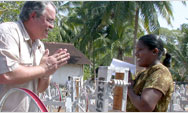 |
|
 |
 |
|
 |
 |
 |
USAID Information:
External Links:
|
|
 |
 |
|
This is an archived USAID document retained on this web site as a matter of public record.
President's International Education Initiative
Expanded Education for the World's Poorest Children
Ghana Fact Sheet
FOR IMMEDIATE RELEASE
September 24, 2007
Press Office: 202-712-4320
Public Information: 202-712-4810
www.usaid.gov
Education Overview
While facing challenges reaching Education for All goals, Ghana has realized modest gains in basic education achievement. Enrollment rates increased from 57% in 1999 to 90% in 2006, and the percentage of girls in school has gone up. However, rates are still low in many places, particularly rural areas and the northern regions of the country. In northern Ghana, partly due to increased incidences of food insecurity, more than 40% of girls at the basic level are not in school. Low quality of education adversely affects retention and primary school completion. At the primary level, 20% of all children are out of school and only 16% of students read at grade level. U.S. assistance to Ghana increases access and improves education quality. By the end of FY 2008, primary net enrollment and completion rates are expected to reach 73% and 75%, respectively, and the percentage of primary school children reading at grade level will increase to 20%.
Key Elements of the Fast Track Initiative (FTI)
The Ghana FTI plan, building on the Education Strategic Plan, focuses on teacher development, deployment and supervision; reforming management of schools' education planning; infrastructure; and partnering with parents, civic society and non-governmental organizations. There is a high degree of coordination among donors and the Government of Ghana around the plan, with the United States chairing the Education Sector Working Group. The other donors in the education sector are the United Kingdom, the Netherlands, Japan, France, the European Union, the World Bank and UNICEF. The Ghana FTI plan was endorsed in 2004, and Ghana has received an allocation of $33 million from the FTI Catalytic Fund since 2005. The Fast Track Initiative was created in 2002 as a partnership between developing countries and donors to accelerate the delivery of universal primary education in the world's poorest countries.
Current Program
The U.S. Agency for International Development (USAID) has supported government efforts to provide quality education through strengthening communities, parents, and Parent-Teacher Associations' participation in the management of primary schools in their communities. The program has improved primary education through teacher training to improve student reading skills. USAID also developed a Literacy Acceleration Program to assist the Ghana's Ministry of Education (MOE) develop and maintain a national literacy approach to train 9,000 teachers annually. Under the President's African Education Initiative, USAID provides girls with scholarships and textbooks as well as learning materials to schools.
Illustrative Next Steps of the New Initiative
USAID could support interventions to: 1) increase the percentage of children, especially girls, enrolled in primary school; 2) increase the percentage of primary school-age children able to read at grade level; 3) improve school management and accountability systems; and 4) increase community involvement in schools. In addition, USAID could work with the MOE and other donors to explore early-grade learning, as this would increase learning potential and, thereby, improve primary school retention. The short-term goals of these interventions would be to minimize school attendance barriers and enhance school instructional processes for improved student achievement. Long-term results could include expanded access to higher education, improved labor force quality and broader participation in the democratic process.
Mrs. Bush's Remarks at a Global Health and Literacy Luncheon
Back to Top ^
|


